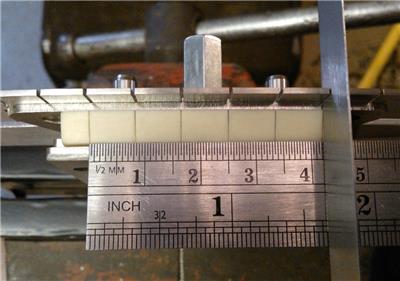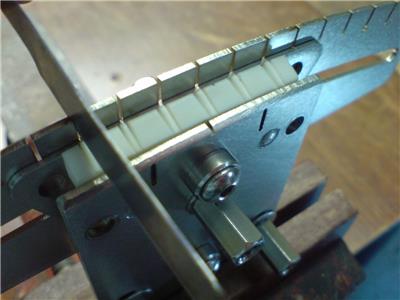NUT PROFILING / STRING SPACING / FRETWORK TOOL PACKAGE
Guitar Nut & Saddle Vice.TOOL KIT CONTENTS:
Nut Top Profile Templates for 7.25", 9.5", 10", 12", 14", 16", 17", 20" & Flat.
String Action Setting Guides for 7.25", 9.5", 10", 12", 14", 16", 17", 20" & Flat.
Radius Gauges for 7.25", 9.5", 10", 12", 14", 16", 17" & 20".
Proportional Guitar String Spacing Guide.
String Position Marking Saw.
String Spacing Diagrams.
Fret Clamping & Profile Plates 7.25", 9.5", 10", 12", 14", 16", 17", 20" & Flat.
0.023" Kerf Width (0.6mm) Fret Slot Cleaning Saw.
“Solid and beautifully made. Quality item”. Andrew F., Inverness, UK.
“I just want to say that the jig is a brilliant tool. I have made a number of nuts and they have all turned out perfect”. Gary S. Australian Capital Territory.
“Amazing product, real quality and so much for the price. You cannot go wrong”. Lyndon S., Worcestershire, UK.
“Just wanted to thank you personally!. The price is totally amazing for this fantastic tool. Wow. Impressed!. I will be buying a few other items from you soon”. Ramon Z., USA.
UNI-JIG GUITAR STRING SPACING SYSTEM
PROPORTIONAL GUITAR STRING SPACING GUIDE
The Proportional Guitar String Spacing Guide ensures precise string positioning and optimised spacing.
The slots are proportionally spaced allowing for a progressive increase in adjacent string gauges from treble to bass.
The String Spacing Guide slots are numerically referenced and laminated diagrams are provided which enable string centres to be easily identified.
STRING CENTRES OBTAINABLE:
4-String Guitar: 20.4 to 27.1mm (17 increments)5-String Guitar: 27.4 to 35.8mm (16 increments)6-String Guitar: 34.6 to 44.4mm (15 increments)7-String Guitar: 41.8 to 52.7mm (14 increments)8-String Guitar: 49.3 to 61.0mm (13 increments)Additional guides to accommodate instruments outside the ranges above are also available - please enquire for further details.PROPORTIONAL SPACING:
Note the slight progressive increase in adjacent string positions for a 6-string Bass Guitar with 42.1mm overall string centres - from highest to lowest indicated by the rule.
Moving the string spacing finder 1-pitch to the right in the photo would reduce the overall centres to 41.4mm, and moving 1-pitch to the left would increase this to 42.9 centres.
(Rule not included).
"I read the instructions, did a practice run, and then made the actual nut. The string spacing was perfect, no guesswork, no measuring involved. It was such a simple task to undertake. Thank you for perfecting such a fantastic Jig". Wayne T, New South Wales, Australia.
NOMINAL STRING HEIGHT:
The Jig is designed to position the strings at a nominal 0.5mm above the 1st Fret. This distance is variable dependent on the bend radius of the string at the nut, angle to the tuners, string gauge, subtleties in nut shape, and also fret thickness.
Dependent on the action required, final adjustment can either be performed on the instrument, or by refitting to the jig and utilising the optional fine adjustment feature detailed below.
OPTIONAL - FINE ADJUSTMENT OF STRING HEIGHT:
This optional feature enables fine adjustments to be performed off the instrument with relative ease and comfortable vision. For precise adjustment, the amount required can be selected from a range of gauged inserts in 0.002” (0.05mm) increments up to a total of 0.028” (0.75mm). The inserts are used to raise the nut in the jig and the slots are then re-filed to the adjusted depth controlled by the action setting plate.
This technique enables controlled micro adjustments to be made and extremely low action to be consistently achieved.
Optional price for Fine Adjustment Gauges : 8.95 GBP.
Please specify when ordering if required. A revised invoice will be forwarded.
12 STRING INSTRUMENTS
12 string slot configurations can be achieved by allowing approx 2.5mm extra for the outer string position at the bass side when marking out. After marking the 1st group of six slots, the guide is then moved along to the next pitch (increased overall 'E' to 'E' on the guide) and positioned to mark the 2nd group of six with an initial spacing of 2mm at high 'E'. Each paired spacing width will then increase proportionally up to low 'E'. (Approx 2.0mm to 2.5mm).
Dependent on range selected and gauge of strings used, some minor adjustment of individual positions may be necessary.
“My very first attempt at making a nut came out perfect and it was for a 12-string so there was lots of room for error but the jig worked perfectly”. Heath J., Utah USA.
Mandolin centres can be achieved using the same principle.
FRET PROFILE JIG PLATES
ACCURATELY PREPARED FRETS WITHOUT SPECIAL TOOLS.
“A really great piece of kit. Very well made. A complete re-fret went without a hitch, Every one came out perfect, What could have been quite a daunting task, went so smoothly. The whole thing has been so well thought out - it's a brilliant bit of kit. I would gladly recommend your equipment to anyone who is thinking of buying it! Thanks again.” Peter C. Wiltshire, UK.
“What a well,thought out tool for holding fret wire and superb quality engineering”. Brian W. Halifax, UK.
OVERVIEW
The fret profile plates assist detail work including length cutting and tang removal, enabling these tasks to be accomplished using basic workshop tools.
ADVANTAGES
NO SPECIAL CUTTING TOOLSThe fretwire can be accurately cut to length using a fine tooth junior hacksaw, the tang can be removed with a small needle file.
SNAG/DISTORTION FREE ENDSAs the fretwire is firmly clamped on the tang either side of the central jig slot, snagging of the fret wire and distortion of the fret ends is avoided as the cut is made.
IMPROVED PREPARATIONWaste is reduced and the the cut produces a clean/usable end for the next fret start.
FRETBOARD RADII COMPARISONMARK REQUIRED FRET LENGTH
Mark the required fret length allowing a small amount for finishing and re-position the fretwire in the jig for cutting to length.
DRESS ENDS / REMOVE TANG
De-burr the ends, file to length leaving minimal amount for finishing on the instrument.
The tang can be easily and neatly removed with a small file by clamping the jig on its side at the end of the vice.
|
DISPATCH:
Current dispatch time is 3 working days from receipt of payment (excluding weekends).
All shipping is via TRACKED or SIGNED FOR courier service.
The purchaser will be responsible for any national and local import duties due in the country/region where the goods are received. These will normally be paid for by the delivery carrier on entering the country and will be invoiced separately to the recipient of the goods. If in doubt, please check with your local customs office to establish if any duty will be payable.
A full refund will be provided if you are not satisfied with your purchase - see details.













